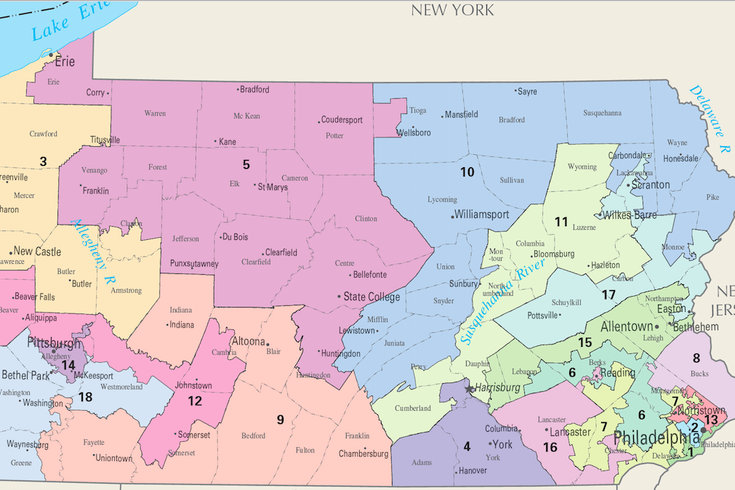
November 06, 2018
 Public Domain/U.S. Dept. of the Interior
Public Domain/U.S. Dept. of the Interior
Pennsylvania's congressional districts are considered among the most gerrymandered in the United States.
The U.S. House of Representatives swung back to Democratic control on Tuesday night, and millions of voters across Pennsylvania cast their ballots for the state’s 18 House Districts.
Some district races were expected to be runaways — one was even uncontested — but an eastern Pennsylvania race proved to be one of the closest-watched in the country, and the Keystone State made a few statements of its own.
Democrats won 9 of the state’s 18 congressional districts, flipping four districts and losing one. Republicans held on to hotly-contested District 1, where incumbent Republican Brian Fitzpatrick was able to fend off Democratic challenger Scott Wallace in a race considered a toss-up.
Fitzpatrick won a race which wound up being more expensive than the U.S. Senate race between Bob Casey and Lou Barletta.
Hillary Clinton won what is now District 1 by a scant two points in the 2016 presidential election, and Barack Obama won it by a single point over Mitt Romney in 2012. It’s a tightly-contested district from both sides.
The race was seen as a possible sign of things to come in Pennsylvania, and perhaps nationwide, by some:
Still very optimistic for PA suburbs, the key one to watch is #PA01 in Bucks County. Very tough for Dems to defeat an incumbent, well-known Congressman. If they do that, look out. https://t.co/zJXQrde1rL
— Chris Matthews (@HardballChris) November 7, 2018
And indeed, the District 1 foretold the fate of two others in the Keystone State. Pennsylvania's 10th and 16th districts ended up in favor of incumbent Republicans in razor-thin margins after their respective Democratic opponents spent most of the night in the lead. Incumbent Republican Scott Perry topped Democratic challenger George Scott in the District 10, and Republican incumbent Mike Kelly defeated Democratic challenger Ron DiNicola in the District 16, completing a trio of squeaker victories for the GOP.
The biggest through line of Tuesday, both locally and also nationally, was the sheer turnout from voters.
In 2014, just under 37 percent of eligible voters turned out to vote nationwide, the lowest level of voter turnout seen in a midterm since World War II.
On Tuesday in Philadelphia, despite a day blanketed with dark gray skies and sometimes-torrential rainfall, voters turned out in droves.
Full voting results are still falling in line, but an all-day crowdsourcing effort from Philadelphia voters, organized by the folks at Sixty-Six Wards, believes the city turned out more than 500,000 voters, which would represent an improvement of more than 30 percent vs. the 2014 midterm elections.
Philadelphia City Councilwoman Helen Gym noted the enthusiasm Tuesday night after spending the day getting out the vote across the city:
I have no idea how this day will end but I will say that having criss-crossed this city, I am inspired for days by the level and breadth of voter turnout. 1/
— Helen Gym (@HelenGym2015) November 7, 2018
And the nationwide trend was one of increased voter turnout, especially from Democrats:
We should be talking about the projected raw popular vote totals much more. In terms of raw votes, this is shaping up to be a massive wave. That it may not translate into an enormous margin in a wave of seats is an indictment of how we draw districts more than anything. pic.twitter.com/D0j96RbjCs
— Brian Klaas (@brianklaas) November 7, 2018
In pure numbers, what we saw was a more engaged country this time around compared to four years ago.
Outside of Democrats taking back the majority in the House, though, what was the bigger picture?
The buzzword of the midterms at a national level had been “Blue Wave” from those hopeful that Democrats would push back after President Donald Trump’s election in 2016.
But, as those close victories in Pennsylvania highlighted, CNN pundit Jake Tapper didn’t see Tuesday night as indicative of any kind of major Blue Wave:
CNN's Jake Tapper: This is NOT a blue wave. pic.twitter.com/UYgF5BLVTE
— Caleb Hull 🎅🏼🌲🎁 (@CalebJHull) November 7, 2018
With Andrew Gillum’s inability to win Florida’s governor's race; Ted Cruz’s close win over Beto O’Rourke in Texas; and a number of House races around the country not falling the way aggressive Democrats had hoped, it became hard for anyone to call Tuesday’s national results a true Blue Wave as the night beat on.
MSNBC panel can't hide its disappointment and simmering anger over no #BlueWave
— jd mullane ☮️ (@jdmullane) November 7, 2018
Instead it was more of a Blue Nudge, including here in Pennsylvania. Everyone now turns their attention to the big show in 2020.
Follow Adam & PhillyVoice on Twitter: @adamwhermann | @thePhillyVoice
Like us on Facebook: PhillyVoice
Add Adam's RSS feed to your feed reader
Have a news tip? Let us know.